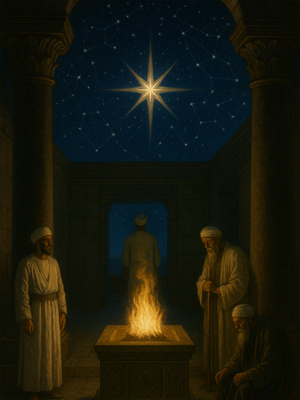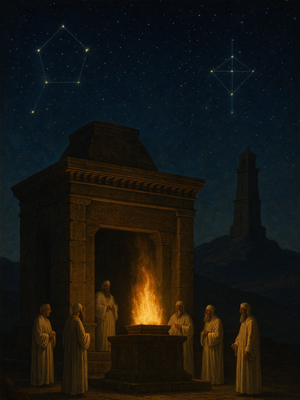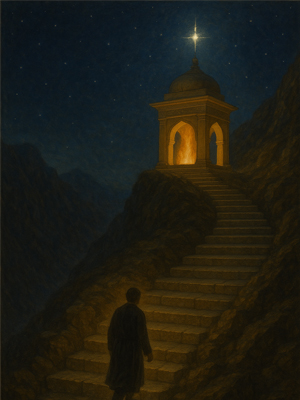Masonic Articles and Essays
The Persian Magi and the Roots of Freemasonry
Exc. Bro... Aksel Suvari 18°
Date Published:
10/1/2025
Long before the Temple of Solomon rose in Jerusalem, a priesthood in ancient Persia tended eternal flames and read the heavens as divine scripture. These were the Magi, guardians of Asha, cosmic order, whose doctrines of light and darkness, celestial law, and sacred architecture shaped the spiritual DNA of later civilizations. Their influence flowed through Judaism, Christianity, and classical philosophy, leaving indelible marks on the symbols and initiatory ideals of Freemasonry itself. Could the Craft’s blazing star, twin pillars, and temple symbolism be far older than we think, reaching back to the fire-altars of the first light?
 Long before the chisel struck stone at Solomon’s Temple, before the Doric columns rose on the Acropolis, before Rome had even dreamt its empire, there existed upon the Iranian plateau a priesthood whose vision encompassed heaven and earth alike. They called themselves the Magavan, “bearers of the sacred knowledge,” but history knows them as the Magi. These were not mere priests tending hearth-altars, nor village astrologers plying a trade of omens. They were custodians of cosmic order (asha), interpreters of the divine law, and mediators between the eternal and the temporal. To understand the genesis of Freemasonry, its symbols, its ideals, its very reason for being, one must look not only to the Temple of Solomon or the Collegia of Rome, but beyond them, to the fire-lit sanctuaries and star-crowned towers of ancient Persia.
Long before the chisel struck stone at Solomon’s Temple, before the Doric columns rose on the Acropolis, before Rome had even dreamt its empire, there existed upon the Iranian plateau a priesthood whose vision encompassed heaven and earth alike. They called themselves the Magavan, “bearers of the sacred knowledge,” but history knows them as the Magi. These were not mere priests tending hearth-altars, nor village astrologers plying a trade of omens. They were custodians of cosmic order (asha), interpreters of the divine law, and mediators between the eternal and the temporal. To understand the genesis of Freemasonry, its symbols, its ideals, its very reason for being, one must look not only to the Temple of Solomon or the Collegia of Rome, but beyond them, to the fire-lit sanctuaries and star-crowned towers of ancient Persia.
The Magi emerged from the reforms of Zarathustra (Zoroaster), a prophet whose life, though obscured by the mists of antiquity, is most often placed between the second and first millennia BCE. His revelation was not the invention of a new faith but a purification of the primordial Aryan religion, which had already conceived the cosmos as a struggle between Truth (Asha) and the Lie (Druj), Light and Darkness, Order and Chaos. Ahura Mazda, the Wise Lord, was the source of all good; Angra Mainyu, the hostile spirit, was the source of corruption. Humanity’s task was to align itself with Asha, the cosmic truth, and thereby become a conscious participant in the maintenance of the world’s divine order.
The Magi institutionalized this doctrine. They became the priestly caste of the Median and later Achaemenid empires, serving as astronomers, ritualists, and political advisors from the court of Cyrus the Great to that of Darius and Xerxes. Their fire-temples, scattered from Bactria to Lydia, were not places of idol worship but of metaphysical contemplation. At their heart burned the sacred flame, never extinguished, never sullied, symbolizing the boundless Light from which all creation flows. This was not fire as substance but fire as principle, the manifest presence of Truth, illuminating and purifying all it touched.
The Magi understood the universe as a vast and ordered structure governed by immutable laws. Their study of the stars was no mere curiosity, it was the deciphering of the divine script. Each star was a yazata, a “worthy one,” embodying an aspect of Ahura Mazda’s thought, and each planet traced a path that mirrored the unfolding of cosmic intention. From the Chaldeans they absorbed mathematical astronomy, from their own Indo-Iranian inheritance they retained the vision of a living, ensouled cosmos. In this synthesis lay the foundations of classical astrology as it would later pass into Babylonian, Hellenistic, and Islamic science.
This cosmology carried profound ethical implications. To the Magian sage, the motion of the heavens was not merely predictive but prescriptive, the cosmos demonstrated order, and man, if he would be wise, must order himself likewise. The fravashi, the ideal self or guardian spirit, was the model toward which each man strove, and the initiate’s path consisted of purifications and ordeals intended to align the lower nature with the higher. Through discipline, contemplation, and service, the Magus sought not to dominate nature but to participate in its harmony.
It is here, in the ethical and symbolic core of Magian doctrine, that we find the germ of what would millennia later become the Masonic ideal. Freemasonry too conceives of the universe as a temple governed by law, wherein man’s task is to bring himself into consonance with the Grand Architect’s design. Its rituals speak of the victory of Light over Darkness, of Truth over Error, and of the gradual ascent of the soul through stages of purification and enlightenment. The initiate, like the Magian fravashi, is called to refine the rough ashlar of his nature into the perfect stone, fit for the celestial edifice.
 The architectural symbolism of Masonry, its pillars, its orientation to the cardinal points, its starry canopy, has unmistakable antecedents in Magian temple design. The fire-altars of ancient Media were constructed on elevated platforms, often aligned with solstitial or equinoctial risings, their sacred flames serving as the terrestrial reflection of the cosmic fire above. The celestial vault painted upon the lodge ceiling is but a descendant of the Magi’s practice of reading the heavens as the temple’s true roof. Even the “blazing star” at the center of the Masonic Lodge recalls the Magian reverence for Tishtrya (Sirius), the divine herald of rain and fertility, or for the eternal light of the Pole Star, fixed, unerring, and central amid the whirling host.
The architectural symbolism of Masonry, its pillars, its orientation to the cardinal points, its starry canopy, has unmistakable antecedents in Magian temple design. The fire-altars of ancient Media were constructed on elevated platforms, often aligned with solstitial or equinoctial risings, their sacred flames serving as the terrestrial reflection of the cosmic fire above. The celestial vault painted upon the lodge ceiling is but a descendant of the Magi’s practice of reading the heavens as the temple’s true roof. Even the “blazing star” at the center of the Masonic Lodge recalls the Magian reverence for Tishtrya (Sirius), the divine herald of rain and fertility, or for the eternal light of the Pole Star, fixed, unerring, and central amid the whirling host.
The question inevitably arises: by what historical channels might Magian doctrine have flowed into the streams that nourished Masonry? The answer is complex but discernible. The first great transmission occurred during the Persian imperial period. The Achaemenids ruled not only Persia but also Mesopotamia, Anatolia, and the Levant. It was under their aegis that the Hebrew exiles returned from Babylon to build the Second Temple, an event that left unmistakable traces of Persian religious influence upon Judaism. The dualism of Light and Darkness in post-exilic texts, the development of angelology, and even the apocalyptic vision of cosmic struggle all bear Magian fingerprints.
Through Judaism, these ideas passed into early Christianity, which adopted not only the terminology of Light and Darkness but also the conception of a cosmic moral order upheld by the Logos. The very word “Magi” enters the Christian tradition through the Gospel of Matthew, where it is Magian sages, not Jewish priests or Roman augurs, who first recognize and pay homage to the incarnate Light in Bethlehem.
Later transmissions occurred through Hellenistic syncretism. The Greeks, encountering Zoroastrianism in the eastward campaigns of Alexander, associated the Magi with their own mysteries. Plato’s conception of the Good as the source of all being, the Stoic notion of a rational cosmic fire (pneuma), and the Hermetic image of man as a microcosm reflecting the macrocosm all resonate with Magian metaphysics. The Neoplatonists of late antiquity, in turn, transmitted these doctrines into the intellectual bloodstream of medieval Christendom, where they mingled with Hebrew Kabbalah and Islamic falsafa. By the time operative Masonry began to assume a speculative form in the seventeenth and eighteenth centuries, these currents, Magian, Hebraic, Platonic, Hermetic, had long been interwoven. The builders of Gothic cathedrals were heirs to a lineage of thought that stretched back not merely to the Temple of Solomon, but beyond it, to the fire-temples of ancient Iran.
Symbols, as René Guénon observed, are the language of the primordial tradition. Across cultures and ages, they preserve truths that elude literal formulation. The Magi and the Masons, though separated by millennia, share a symbolic vocabulary that betrays a common origin. In Magian ritual, the undying flame symbolized the eternal Light and the presence of Asha. In Masonry, the “Great Light,” the divine spark within, is the guiding principle by which the initiate orders his life. Magian temples were often flanked by twin columns symbolizing the cosmic dualities of Light and Darkness, Spirit and Matter. The Masonic Boaz and Jachin stand as their descendants, representing the balance of opposing principles within the temple and within man. The Magi read the stars as the script of divine intelligence. Masonry places the blazing star at the heart of the Lodge as the emblem of divine guidance and illumination. The Magian aspirant underwent successive purifications before becoming a fravashi. The Mason progresses through degrees, each marking a step in the ascent from ignorance to illumination. These are not coincidences but echoes, distant, transmuted, and reinterpreted, yet recognizably born of a single source: the primordial quest to bring human life into harmony with cosmic order.
Freemasonry has often described itself as a “peculiar system of morality, veiled in allegory and illustrated by symbols.” Too often, however, this is interpreted as a mere rhetorical flourish. In truth, it is a statement of lineage. The allegories are ancient, the symbols primordial. They belong to a perennial wisdom that has clothed itself in many garments, Zoroastrian in Persia, Mosaic in Israel, Platonic in Greece, Hermetic in Alexandria, and Masonic in the West.
 To recognize the Magian roots of Masonry is not to diminish its later expressions but to deepen their significance. It is to understand that the Craft is not an invention of the Enlightenment nor a relic of medieval guilds, but a living heir to a tradition as old as civilization itself, a tradition that has always taught that man’s highest calling is to become a conscious participant in the cosmic order, a builder of harmony in the temple of the world. The Magi called this alignment Asha. The Greeks called it Logos. The medieval Christians called it the ordo divinus. Freemasonry calls it the work of the Grand Architect. Different names, one Light. And it is that same Light, the “First Light” of which the Magi were guardians, that continues to burn upon the altar of the Lodge, beckoning every initiate to rise from the shadows and walk in harmony with the eternal.
To recognize the Magian roots of Masonry is not to diminish its later expressions but to deepen their significance. It is to understand that the Craft is not an invention of the Enlightenment nor a relic of medieval guilds, but a living heir to a tradition as old as civilization itself, a tradition that has always taught that man’s highest calling is to become a conscious participant in the cosmic order, a builder of harmony in the temple of the world. The Magi called this alignment Asha. The Greeks called it Logos. The medieval Christians called it the ordo divinus. Freemasonry calls it the work of the Grand Architect. Different names, one Light. And it is that same Light, the “First Light” of which the Magi were guardians, that continues to burn upon the altar of the Lodge, beckoning every initiate to rise from the shadows and walk in harmony with the eternal.
The chain of transmission is long and complex, yet its course is discernible to the patient eye. From the fire-temples of ancient Persia to the star-vaulted Lodges of the modern world, a single idea persists: that man’s destiny is not to rule the cosmos but to understand it, not to impose order but to reflect it, not to build in stone alone but to build within himself the temple of Light. The Magi were its first custodians. The Freemasons are among its latest. And the flame, that undying symbol of Asha, still burns.
More Masonic Articles
Explore articles and essays written by Freemasons about Freemasonry.
Read More
Membership
Interested in becoming a member of the worlds oldest Fraternal organization?
Read More